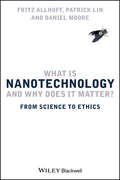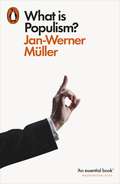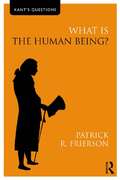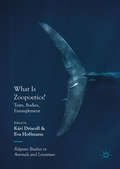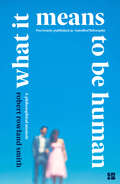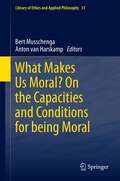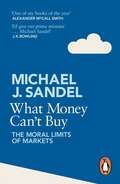- Table View
- List View
What Is Nanotechnology and Why Does It Matter?: From Science to Ethics
by Fritz Allhoff Patrick Lin Daniel MooreOngoing research in nanotechnology promises both innovations and risks, potentially and profoundly changing the world. This book helps to promote a balanced understanding of this important emerging technology, offering an informed and impartial look at the technology, its science, and its social impact and ethics. Nanotechnology is crucial for the next generation of industries, financial markets, research labs, and our everyday lives; this book provides an informed and balanced look at nanotechnology and its social impact Offers a comprehensive background discussion on nanotechnology itself, including its history, its science, and its tools, creating a clear understanding of the technology needed to evaluate ethics and social issues Authored by a nanoscientist and philosophers, offers an accurate and accessible look at the science while providing an ideal text for ethics and philosophy courses Explores the most immediate and urgent areas of social impact of nanotechnology
What Is Philosophy for?
by Mary MidgleyWhy should anybody take an interest in philosophy? Is it just another detailed study like metallurgy? Or is it similar to history, literature and even religion: a study meant to do some personal good and influence our lives? Mary Midgley addresses these provocative questions in her most up-to-date statement on the various forms of our current intellectual anxieties and confusions and how we might deal with them. In doing so, she provides a robust, yet not uncritical, defence of philosophy and the life of the mind.This defence is expertly placed in the context of contemporary debates about science, religion, and philosophy. It asks whether, in light of rampant scientific and technological developments, we still need philosophy to help us think about the big questions of meaning, knowledge, and value.
What Is Philosophy for?
by Mary MidgleyWhy should anybody take an interest in philosophy? Is it just another detailed study like metallurgy? Or is it similar to history, literature and even religion: a study meant to do some personal good and influence our lives? In her last published work, Mary Midgley addresses provocative questions, interrogating the various forms of our current intellectual anxieties and confusions and how we might deal with them. In doing so, she provides a robust, yet not uncritical, defence of philosophy and the life of the mind.This defence is expertly placed in the context of contemporary debates about science, religion, and philosophy. It asks whether, in light of rampant scientific and technological developments, we still need philosophy to help us think about the big questions of meaning, knowledge, and value.
What Is Populism?
by Jan-Werner Müller'There is no better guide to the populist passions of the present' The New York TimesDonald Trump, Silvio Berlusconi, Marine Le Pen, Hugo Chávez - populists are on the rise across the globe. But what exactly is populism? Should everyone who criticizes Wall Street or Washington be called a populist? What precisely is the difference between right-wing and left-wing populism? Does populism bring government closer to the people or is it a threat to democracy? Who are "the people" anyway and who can speak in their name? These questions have never been more pressing.In this provocative book, Jan-Werner Müller argues that at populism's core is a rejection of pluralism. Populists will always claim that they and they alone represent the people and their true interests. Contrary to conventional wisdom, populists can govern on the basis of their claim to exclusive moral representation of the people: if populists have enough power, they will end up creating an authoritarian state that excludes all those not considered part of the proper "people". Proposing a number of concrete strategies for how liberal democrats should best deal with populists, Müller shows how to counter their claims to speak exclusively for "the silent majority".
What Is Right for Children?: The Competing Paradigms of Religion and Human Rights
by Martha Albertson Fineman Karen WorthingtonCombining feminist legal theory with international human rights concepts, this book examines the presence, participation and treatment of children in a variety of contexts. Specifically, through comparing legal developments in the US with legal developments in countries where the views that children are separate from their families and potentially in need of state protection are more widely accepted. The authors address the role of religion in shaping attitudes about parental rights in the US, with particular emphasis upon the fundamentalist belief in natural lines of familial authority. Such beliefs have provoked powerful resistance in the US to human rights approaches that view the child as an independent rights holder and the state as obligated to proved services and protections that are distinctly child-centred. Calling for a rebalancing of relationships within the US family, to become more consistent with emerging human rights norms, this collection contains both theoretical debates about and practical approaches to granting positive rights to children.
What Is Right for Children?: The Competing Paradigms of Religion and Human Rights
by Martha Albertson Fineman Karen WorthingtonCombining feminist legal theory with international human rights concepts, this book examines the presence, participation and treatment of children in a variety of contexts. Specifically, through comparing legal developments in the US with legal developments in countries where the views that children are separate from their families and potentially in need of state protection are more widely accepted. The authors address the role of religion in shaping attitudes about parental rights in the US, with particular emphasis upon the fundamentalist belief in natural lines of familial authority. Such beliefs have provoked powerful resistance in the US to human rights approaches that view the child as an independent rights holder and the state as obligated to proved services and protections that are distinctly child-centred. Calling for a rebalancing of relationships within the US family, to become more consistent with emerging human rights norms, this collection contains both theoretical debates about and practical approaches to granting positive rights to children.
What is Sustainable Technology?: Perceptions, Paradoxes and Possibilities
by Karel Mulder Didac Ferrer Harro van LenteDesigners of technology have a major responsibility in the current age. Their designs can have tremendous effects on society, in both the short and the long term. In fact, sustainable development itself has all the characteristics of a design project, albeit a vast one. But a failed product design here will be not just be unsuccessful in the market – it will have far-reaching consequences. It is our common responsibility to make the project successful. Technology has played an important role in creating the problems that we now face; but it will also play an important role in solving them. But this does not mean the technological fix will be easy. How do we allocate resources and attention when there are myriad issues under the umbrella of "sustainable development" currently in competition with one another? How do we arrive at precise specifications for the sustainable technologies that are to be developed and, furthermore, reach consensus on these specifications? What if our sustainable technological solutions aggravate other problems or create new ones? And, because sustainable development is all about the long-term consequences of our actions, how do we assess the effects of modifying existing landscapes, infrastructures and patterns of life?How could we be sure in advance that the changes that new technologies bring will make our society more sustainable? These dilemmas and paradoxes are the subject of this provocative book. Sometimes the claim that a technology is sustainable is made in order to make the technology acceptable in the political process, as in the case of nuclear energy production, where the claims of "sustainability" refer to the absence of CO2 emissions. In the case of biofuels, claims of sustainability have led to a "fuel or food" debate, showing that sustainability has counteracting articulations. And the well-known rebound effect is observed when increased resource efficiency can create a stimulus for consumption. What is Sustainable Technology? illustrates that the sustainability impact of a technology is often much more complicated and ambivalent than one might expect. Making improvements to existing designs is not the technological challenge that will lead to real solutions. We mustn't look to change a part of a machine, but rather the machine as a whole – or even the whole system in which it functions. It is these system innovations that have the potential to make a genuine contribution to sustainable development. What is Sustainable Technology? will help all those involved in designing more sustainable technologies in determining their strategies. It does so by presenting case studies of different technologies in contrasting contexts. Each case asks: 1. What articulations of sustainability played a role in the design process? 2. What sustainability effects did this technology lead to? 3. Who was affected, where, and when? 4. Could the designer have foreseen these consequences? 5. How did the designer anticipate them? 6. How was societal interaction dealt with during the design process? Finally, the authors reflect on future options for the sustainable technology designer. They argue that an important first step is an awareness of the multitude of sustainable development challenges that play a role in production, use, recycling and end-of-life disposal. What is Sustainable Technology? will be essential reading for product designers, engineers, material scientists and others involved in the development of sustainable technologies, as well as a wide academic audience interested in the complexities of the sustainable design process.
What is Sustainable Technology?: Perceptions, Paradoxes and Possibilities
by Karel Mulder Didac Ferrer Harro van LenteDesigners of technology have a major responsibility in the current age. Their designs can have tremendous effects on society, in both the short and the long term. In fact, sustainable development itself has all the characteristics of a design project, albeit a vast one. But a failed product design here will be not just be unsuccessful in the market – it will have far-reaching consequences. It is our common responsibility to make the project successful. Technology has played an important role in creating the problems that we now face; but it will also play an important role in solving them. But this does not mean the technological fix will be easy. How do we allocate resources and attention when there are myriad issues under the umbrella of "sustainable development" currently in competition with one another? How do we arrive at precise specifications for the sustainable technologies that are to be developed and, furthermore, reach consensus on these specifications? What if our sustainable technological solutions aggravate other problems or create new ones? And, because sustainable development is all about the long-term consequences of our actions, how do we assess the effects of modifying existing landscapes, infrastructures and patterns of life?How could we be sure in advance that the changes that new technologies bring will make our society more sustainable? These dilemmas and paradoxes are the subject of this provocative book. Sometimes the claim that a technology is sustainable is made in order to make the technology acceptable in the political process, as in the case of nuclear energy production, where the claims of "sustainability" refer to the absence of CO2 emissions. In the case of biofuels, claims of sustainability have led to a "fuel or food" debate, showing that sustainability has counteracting articulations. And the well-known rebound effect is observed when increased resource efficiency can create a stimulus for consumption. What is Sustainable Technology? illustrates that the sustainability impact of a technology is often much more complicated and ambivalent than one might expect. Making improvements to existing designs is not the technological challenge that will lead to real solutions. We mustn't look to change a part of a machine, but rather the machine as a whole – or even the whole system in which it functions. It is these system innovations that have the potential to make a genuine contribution to sustainable development. What is Sustainable Technology? will help all those involved in designing more sustainable technologies in determining their strategies. It does so by presenting case studies of different technologies in contrasting contexts. Each case asks: 1. What articulations of sustainability played a role in the design process? 2. What sustainability effects did this technology lead to? 3. Who was affected, where, and when? 4. Could the designer have foreseen these consequences? 5. How did the designer anticipate them? 6. How was societal interaction dealt with during the design process? Finally, the authors reflect on future options for the sustainable technology designer. They argue that an important first step is an awareness of the multitude of sustainable development challenges that play a role in production, use, recycling and end-of-life disposal. What is Sustainable Technology? will be essential reading for product designers, engineers, material scientists and others involved in the development of sustainable technologies, as well as a wide academic audience interested in the complexities of the sustainable design process.
What is the Human Being?
by Patrick R. FriersonPhilosophers, anthropologists and biologists have long puzzled over the question of human nature. It is also a question that Kant thought about deeply and returned to in many of his writings. In this lucid and wide-ranging introduction to Kant’s philosophy of human nature - which is essential for understanding his thought as a whole - Patrick R. Frierson assesses Kant’s theories and examines his critics. He begins by explaining how Kant articulates three ways of addressing the question ‘what is the human being?’: the transcendental, the empirical, and the pragmatic. He then considers some of the great theorists of human nature who wrestle with Kant’s views, such as Hegel, Marx, Darwin, Nietzsche, and Freud; contemporary thinkers such as E.O.Wilson and Daniel Dennett, who have sought biological explanations of human nature; Thomas Kuhn, Michel Foucault, and Clifford Geertz, who emphasize the diversity of human beings in different times and places; and existentialist philosophers such as Sartre and Heidegger. He argues that whilst these approaches challenge and enrich Kant’s views in significant ways, all suffer from serious weaknesses that Kant’s anthropology can address. Taking a core insight of Kant’s - that human beings are fundamentally free but finite - he argues that it is the existentialists, particularly Sartre, who are the most direct heirs of his transcendental anthropology. The final part of the book is an extremely helpful overview of the work of contemporary philosophers, particularly Christine Korsgaard and Jürgen Habermas. Patrick R. Frierson explains how these philosophers engage with questions of naturalism, historicism, and existentialism while developing Kantian conceptions of the human being. Including chapter summaries and annotated further reading, What is the Human Being? is an outstanding introduction to some fundamental aspects of Kant’s thought and a judicious assessment of leading theories of human nature. It is essential reading for all students of Kant and the philosophy of human nature, as well as those in related disciplines such as anthropology, politics and sociology.
What is the Human Being? (Kant's Questions)
by Patrick R. FriersonPhilosophers, anthropologists and biologists have long puzzled over the question of human nature. It is also a question that Kant thought about deeply and returned to in many of his writings. In this lucid and wide-ranging introduction to Kant’s philosophy of human nature - which is essential for understanding his thought as a whole - Patrick R. Frierson assesses Kant’s theories and examines his critics. He begins by explaining how Kant articulates three ways of addressing the question ‘what is the human being?’: the transcendental, the empirical, and the pragmatic. He then considers some of the great theorists of human nature who wrestle with Kant’s views, such as Hegel, Marx, Darwin, Nietzsche, and Freud; contemporary thinkers such as E.O.Wilson and Daniel Dennett, who have sought biological explanations of human nature; Thomas Kuhn, Michel Foucault, and Clifford Geertz, who emphasize the diversity of human beings in different times and places; and existentialist philosophers such as Sartre and Heidegger. He argues that whilst these approaches challenge and enrich Kant’s views in significant ways, all suffer from serious weaknesses that Kant’s anthropology can address. Taking a core insight of Kant’s - that human beings are fundamentally free but finite - he argues that it is the existentialists, particularly Sartre, who are the most direct heirs of his transcendental anthropology. The final part of the book is an extremely helpful overview of the work of contemporary philosophers, particularly Christine Korsgaard and Jürgen Habermas. Patrick R. Frierson explains how these philosophers engage with questions of naturalism, historicism, and existentialism while developing Kantian conceptions of the human being. Including chapter summaries and annotated further reading, What is the Human Being? is an outstanding introduction to some fundamental aspects of Kant’s thought and a judicious assessment of leading theories of human nature. It is essential reading for all students of Kant and the philosophy of human nature, as well as those in related disciplines such as anthropology, politics and sociology.
What Is the Mishnah?: The State of the Question (Jewish Law and Culture Series)
by Shaye J. D. CohenThe Mishnah is the foundational document of rabbinic Judaism—all of rabbinic law, from ancient to modern times, is based on the Talmud, and the Talmud, in turn, is based on the Mishnah. But the Mishnah is also an elusive document; its sources and setting are obscure, as are its genre and purpose.In January 2021 the Harvard Center for Jewish Studies and the Julis-Rabinowitz Program on Jewish and Israeli Law of the Harvard Law School co-sponsored a conference devoted to the simple yet complicated question: “What is the Mishnah?” Leading scholars from the United States, Europe, and Israel assessed the state of the art in Mishnah studies; and the papers delivered at that conference form the basis of this collection. Learned yet accessible, What Is the Mishnah? gives readers a clear sense of current and future direction of Mishnah studies.
What is this thing called Ethics?
by Christopher BennettWhat is morality? How do we define what is right and wrong? How does moral theory help us deal with ethical issues in the world around us? This second edition provides an engaging and stimulating introduction to philosophical thinking about morality. Christopher Bennett provides the reader with accessible examples of contemporary and relevant ethical problems, before looking at the main theoretical approaches and key philosophers associated with them. Topics covered include: life and death issues such as abortion and global poverty; the meaning of life; whether life is sacred and which lives matter; major moral theories such as utilitarianism, Kantian ethics and virtue ethics; critiques of morality from Marx and Nietzsche. What is this Thing Called Ethics? has been thoroughly revised and updated throughout, with a new final chapter on meta-ethics. With boxed case studies, discussion questions and further reading included within each chapter this textbook is the ideal introduction to ethics for philosophy students coming to the subject for the first time.
What is this thing called Ethics?
by Christopher BennettWhat is morality? How do we define what is right and wrong? How does moral theory help us deal with ethical issues in the world around us? This second edition provides an engaging and stimulating introduction to philosophical thinking about morality. Christopher Bennett provides the reader with accessible examples of contemporary and relevant ethical problems, before looking at the main theoretical approaches and key philosophers associated with them. Topics covered include: life and death issues such as abortion and global poverty; the meaning of life; whether life is sacred and which lives matter; major moral theories such as utilitarianism, Kantian ethics and virtue ethics; critiques of morality from Marx and Nietzsche. What is this Thing Called Ethics? has been thoroughly revised and updated throughout, with a new final chapter on meta-ethics. With boxed case studies, discussion questions and further reading included within each chapter this textbook is the ideal introduction to ethics for philosophy students coming to the subject for the first time.
What is Wrong with Human Trafficking?: Critical Perspectives on the Law
by Rita Haverkamp Ester Herlin-Karnell Claes LernestedtThe overarching objective of this volume is to discuss and critique the legal regulation of human trafficking in national and transnational context. Specifically, discussion is needed not only with regard to the historical and philosophical points of departure for any criminalisation of trafficking, but also, regarding the societal and social framework, the empirical dimension such as existing statistics in the area, and the need for more data. The book combines descriptive and normative analyses of the crime of trafficking in human beings from a cross-legal perspective. Notwithstanding the enhanced interest for human trafficking in politics, the public and the media, a critical perspective such as the one pursued herewith has so far been largely absent. Against this background, this approach allows for theoretical findings to be addressed by pointing out and elaborating different, interdisciplinary conflicts and inconsistencies in the regulation of human trafficking. The book discusses the phenomenon of human trafficking critically from various angles, giving it 'shape' and showing how it comes to life in the legal regulation.
What is Wrong with Human Trafficking?: Critical Perspectives on the Law
by Claes Lernestedt Ester Herlin-Karnell Rita HaverkampThe overarching objective of this volume is to discuss and critique the legal regulation of human trafficking in national and transnational context. Specifically, discussion is needed not only with regard to the historical and philosophical points of departure for any criminalisation of trafficking, but also, regarding the societal and social framework, the empirical dimension such as existing statistics in the area, and the need for more data. The book combines descriptive and normative analyses of the crime of trafficking in human beings from a cross-legal perspective. Notwithstanding the enhanced interest for human trafficking in politics, the public and the media, a critical perspective such as the one pursued herewith has so far been largely absent. Against this background, this approach allows for theoretical findings to be addressed by pointing out and elaborating different, interdisciplinary conflicts and inconsistencies in the regulation of human trafficking. The book discusses the phenomenon of human trafficking critically from various angles, giving it 'shape' and showing how it comes to life in the legal regulation.
What Is Zoopoetics?: Texts, Bodies, Entanglement (Palgrave Studies in Animals and Literature)
by Kári Driscoll Eva HoffmannThis book brings together essays dealing with the question of zoopoetics both as an object of study—i.e. texts from various traditions and periods that reflect, explicitly or implicitly, on the relationship between animality, language and representation—and as a methodological problem for animal studies, and, indeed, for literary studies more generally. What can literary animal studies tell us about literature that conventional literary studies might be blind to? How can literary studies resist the tendency to press animals into symbolic service as metaphors and allegories for the human whilst also avoiding a naïve literalism with respect to the literary animal? The volume is divided into three sections: “Texts,” which focuses on the linguistic and metaphorical dimensions of zoopoetics; “Bodies,” which is primarily concerned with mimesis and questions of embodiment, performance, and lived experience; and “Entanglement,” which focuses on interspecies encounters and the complex interplay between word and world that emerges from them. The volume will appeal to scholars and students in the fields of animal studies, area studies and comparative literature, gender studies, environmental humanities, ecocriticism, and the broader field of posthumanism.
What Is Zoopoetics?: Texts, Bodies, Entanglement (Palgrave Studies in Animals and Literature)
by Kári Driscoll Eva HoffmannThis book brings together essays dealing with the question of zoopoetics both as an object of study—i.e. texts from various traditions and periods that reflect, explicitly or implicitly, on the relationship between animality, language and representation—and as a methodological problem for animal studies, and, indeed, for literary studies more generally. What can literary animal studies tell us about literature that conventional literary studies might be blind to? How can literary studies resist the tendency to press animals into symbolic service as metaphors and allegories for the human whilst also avoiding a naïve literalism with respect to the literary animal? The volume is divided into three sections: “Texts,” which focuses on the linguistic and metaphorical dimensions of zoopoetics; “Bodies,” which is primarily concerned with mimesis and questions of embodiment, performance, and lived experience; and “Entanglement,” which focuses on interspecies encounters and the complex interplay between word and world that emerges from them. The volume will appeal to scholars and students in the fields of animal studies, area studies and comparative literature, gender studies, environmental humanities, ecocriticism, and the broader field of posthumanism.
What it Means to be Human: An Intimate Story Of What It Means To Be Human
by Robert Rowland SmithWhat is the role of fate in our lives? Why should we avoid repeating patterns? And how can we identify our purpose?
What It Means to Be Human: The Case For The Body In Public Bioethics
by O. Carter SneadA leading expert on public bioethics advocates for a new conception of human identity in American law and policy.The natural limits of the human body make us vulnerable and therefore dependent, throughout our lives, on others. Yet American law and policy disregard these stubborn facts, with statutes and judicial decisions that presume people to be autonomous, defined by their capacity to choose. As legal scholar O. Carter Snead points out, this individualistic ideology captures important truths about human freedom, but it also means that we have no obligations to each other unless we actively, voluntarily embrace them. Under such circumstances, the neediest must rely on charitable care. When it is not forthcoming, law and policy cannot adequately respond.What It Means to Be Human makes the case for a new paradigm, one that better represents the gifts and challenges of being human. Inspired by the insights of Alasdair MacIntyre and Charles Taylor, Snead proposes a vision of human identity and flourishing that supports those who are profoundly vulnerable and dependent—children, the disabled, and the elderly. To show how such a vision would affect law and policy, he addresses three complex issues in bioethics: abortion, assisted reproductive technology, and end-of-life decisions. Avoiding typical dichotomies of conservative-versus-liberal and secular-versus-religious, Snead recasts debates over these issues and situates them within his framework of embodiment and dependence. He concludes that, if the law is built on premises that reflect the fully lived reality of life, it will provide support for the vulnerable, including the unborn, mothers, families, and those nearing the end of their lives. In this way, he argues, policy can ensure that people have the care they need in order to thrive.In this provocative and consequential book, Snead rethinks how the law represents human experiences so that it might govern more wisely, justly, and humanely.
What Kind of Death: The Ethics of Determining One’s Own Death (Routledge Research in Applied Ethics)
by Govert den HartoghMany books have been published about physician-assisted death. This book offers a comprehensive and in-depth examination of that subject, but it also extends the discussion to a broader range of end-of-life decisions including suicide, palliative care and sedation until death. In every jurisdiction that has laws permitting some kind of physician-assisted death, a central point of controversy is whether such assistance should only be available to dying patients, or to everyone who wants to end his life. The right to determine the manner and time of one’s own death, however, does not necessarily mean that physicians should be permitted to cooperate in ensuring a quick and peaceful death. In this book, Govert den Hartogh considers the fundamental and practical matters – including concrete issues of legal regulation – related to end-of life decision making. He proposes a two-tiered system. Everyone should have access to humane means of ending his life, if his decision to end it is voluntary, well-considered and durable. But doctors should only participate in a joint action of ending the patient’s life on his request if they also are convinced of acting in the patient’s best interests, in particular by ending intolerable and unrelievable suffering. And perhaps there is reason to restrict that second service to dying patients. The whole argument, however, depends on the extent to which, in both tiers of the system, we can design legal safeguards that will enable us to trust judgments about the requesting person’s request and about his suffering. The book considers much new evidence in regard to this issue. What Kind of Death will appeal to researchers and advanced students working in bioethics, applied ethics, philosophy of law and health law.
What Kind of Death: The Ethics of Determining One’s Own Death (Routledge Research in Applied Ethics)
by Govert den HartoghMany books have been published about physician-assisted death. This book offers a comprehensive and in-depth examination of that subject, but it also extends the discussion to a broader range of end-of-life decisions including suicide, palliative care and sedation until death. In every jurisdiction that has laws permitting some kind of physician-assisted death, a central point of controversy is whether such assistance should only be available to dying patients, or to everyone who wants to end his life. The right to determine the manner and time of one’s own death, however, does not necessarily mean that physicians should be permitted to cooperate in ensuring a quick and peaceful death. In this book, Govert den Hartogh considers the fundamental and practical matters – including concrete issues of legal regulation – related to end-of life decision making. He proposes a two-tiered system. Everyone should have access to humane means of ending his life, if his decision to end it is voluntary, well-considered and durable. But doctors should only participate in a joint action of ending the patient’s life on his request if they also are convinced of acting in the patient’s best interests, in particular by ending intolerable and unrelievable suffering. And perhaps there is reason to restrict that second service to dying patients. The whole argument, however, depends on the extent to which, in both tiers of the system, we can design legal safeguards that will enable us to trust judgments about the requesting person’s request and about his suffering. The book considers much new evidence in regard to this issue. What Kind of Death will appeal to researchers and advanced students working in bioethics, applied ethics, philosophy of law and health law.
What Makes Us Moral? On the capacities and conditions for being moral (Library of Ethics and Applied Philosophy #31)
by Bert Musschenga and Anton van HarskampThis book addresses the question of what it means to be moral and which capacities one needs to be moral. It questions whether empathy is a cognitive or an affective capacity, or perhaps both. As most moral beings behave immorally from time to time, the authors ask which factors cause or motivate people to translate their moral beliefs into action? Specially addressed is the question of what is the role of internal factors such as willpower, commitment, character, and what is the role of external, situational and structural factors? The questions are considered from various (disciplinary) perspectives.
What Market, What Society, What Union?: The Treaty of Amsterdam and the European Thought of Francisco Lucas Pires
by Martinho Lucas Pires Francisco Pereira CoutinhoThis book provides a discussion of some of the most pressing challenges facing EU integration: political and economic governance, constitutional status and citizenship. It does so by discussing the work of one of the most original Portuguese voices in EU studies, Francisco Lucas Pires. In his swan song, here translated into English for the first time, Lucas Pires critically discusses the Treaty of Amsterdam, dissecting the process of its enactment, and its wider consequences for the EU. His profound, original and premonitory observations are commented on in this book by six young, prominent EU law scholars from different research areas.The result is an original and sagacious reflection, aimed both at researchers of EU law and policymakers alike, on the victories and shortcomings of the European project, providing refreshing views on a significant but often-neglected moment in the EU’s history, as well as new avenues of critical thinking for the development of European integration.Martinho Lucas Pires is Ph.D. Candidate at Nova School of Law Lisbon, Assistant lecturer at Católica Law School Lisbon, and Counsel at DLA Piper ABBC Advogados Lisbon, Portugal. Francisco Pereira Coutinho is Associate Professor and Vice-Dean at Nova School of Law Lisbon, Faculty of Law of the NOVA University of Lisbon, Portugal.
What Money Can't Buy: The Moral Limits of Markets (Platinum Nonfiction Ser.)
by Michael SandelShould we pay children to read books or to get good grades? Is it ethical to pay people to test risky new drugs or to donate their organs? What about hiring mercenaries to fight our wars, outsourcing inmates to for-profit prisons, auctioning admission to elite universities, or selling citizenship to immigrants willing to pay? Isn't there something wrong with a world in which everything is for sale? In recent decades, market values have crowded out nonmarket norms in almost every aspect of life-medicine, education, government, law, art, sports, even family life and personal relations. Without quite realizing it, Sandel argues, we have drifted from having a market economy to being a market society. In What Money Can't Buy, Sandel examines one of the biggest ethical questions of our time and provokes a debate that's been missing in our market-driven age: What is the proper role of markets in a democratic society, and how can we protect the moral and civic goods that markets do not honour and money cannot buy?
